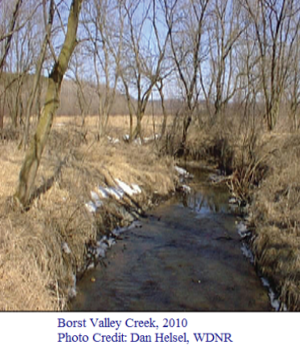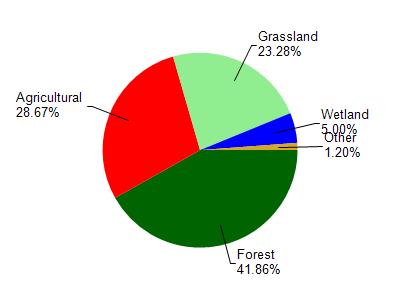
8.18 Miles
0 - 8.18
Cool-Cold Mainstem, Cool-Cold Headwater, Coldwater
2025
Good
Trempealeau
Yes
No
No
Fish and Aquatic Life
Overview
Borst Valley Creek is an eight mile tributary of Elk Creek and is designated as a Class III trout stream for its entire length. Baseflow water chemistry samples collected from the stream within the state wildlife area found total phosphorus concentrations nearly 2.5 times higher than the proposed water quality standard. Land use above the sampling site is mostly undisturbed with the wildlife area comprising nearly 45% of the watershed. Causes of elevated phosphorus concentrations are not known since current watershed land use is mostly protected. High stream concentrations may be the result of historic sediment deposition from poor land use activities, drainage of wetland soils or inputs from groundwater.
Date 2010
Author Mark Hazuga
General Condition
Borst Valley Creek (miles 0-8.18) was assessed during the 2018 listing cycle; new biological (macroinvertebrate and fish Index of Biotic Integrity (IBI) scores) sample data were clearly below the 2018 WisCALM listing thresholds for the Fish and Aquatic Life use. This water was meeting this designated use and was not considered impaired.
Date 2017
Author Ashley Beranek
General Condition
The stream is limited by cropland erosion, stream channelization, animal waste from barnyard runoff and livestock pasturing on the streambanks. This stream can best be characterized by large areas of unprotected eroding streambanks resulting from livestock pasturing.
The portion of Borst Valley Creek in the Borst Valley Wildlife Area demonstrates the stream's ability to improve through streambank protection. Livestock were removed from this portion of the stream after the land was purchased by the DNR. This portion of the stream has improved fishery habitat, natural streambank vegetation which inhibits streambank erosion, and a return of natural meander patterns which are providing deep pool areas and undercut banks. This stream segment represents the potential a stream has when livestock are removed from the streambanks
Date 1991
Author Lisa Helmuth
Condition
Wisconsin has over 84,000 miles of streams, 15,000 lakes and milllions of acres of wetlands. Assessing the condition of this vast amount of water is challenging. The state's water monitoring program uses a media-based, cross-program approach to analyze water condition. An updated monitoring strategy (2015-2020) is now available. Compliance with Clean Water Act fishable, swimmable standards are located in the Executive Summary of Water Condition in 2018. See also the 'monitoring and projects' tab.
Reports
Management Goals
Wisconsin's Water Quality Standards provide qualitative and quantitative goals for waters that are protective of Fishable, Swimmable conditions [Learn more]. Waters that do not meet water quality standards are considered impaired and restoration actions are planned and carried out until the water is once again fishable and swimmable
Management goals can include creation or implementation of a Total Maximum Daily Load analysis, a Nine Key Element Plan, or other restoration work, education and outreach and more. If specific recommendations exist for this water, they will be displayed below online.
Monitoring
Monitoring the condition of a river, stream, or lake includes gathering physical, chemical, biological, and habitat data. Comprehensive studies often gather all these parameters in great detail, while lighter assessment events will involve sampling physical, chemical and biological data such as macroinvertebrates. Aquatic macroinvertebrates and fish communities integrate watershed or catchment condition, providing great insight into overall ecosystem health. Chemical and habitat parameters tell researchers more about human induced problems including contaminated runoff, point source dischargers, or habitat issues that foster or limit the potential of aquatic communities to thrive in a given area. Wisconsin's Water Monitoring Strategy was recenty updated.
Grants and Management Projects
Monitoring Projects
| WBIC | Official Waterbody Name | Station ID | Station Name | Earliest Fieldwork Date | Latest Fieldwork Date | View Station | View Data |
|---|
| 1783100 | Borst Valley Creek | 10008445 | Borst Valley Cr. [600 ft Ds Vehicle X-Ing On State Land] | 11/14/2002 | 8/6/2025 | Map | Data |
| 1783100 | Borst Valley Creek | 10008444 | Sylla Rd. | 4/18/1979 | 1/1/2015 | Map | Data |
| 1783100 | Borst Valley Creek | 623202 | Borst Valley Creek - Sth 121 Sec 2 And 11 | 2/12/1979 | 10/15/2015 | Map | Data |
| 1783100 | Borst Valley Creek | 623205 | Borst Valley Creek - Tn Rd Sec 33 | 9/12/1979 | 1/30/1989 | Map | Data |
| 1783100 | Borst Valley Creek | 10008446 | Station 8 Co. Hwy Vv Downstream | 10/17/1988 | 4/27/1989 | Map | Data |
| 1783100 | Borst Valley Creek | 10021007 | Borst Valley Creek | | | Map | Data |
| 1783100 | Borst Valley Creek | 10008447 | Station 9 Espeleth Valley Rd | 11/18/2009 | 11/18/2009 | Map | Data |
| 1783100 | Borst Valley Creek | 10008443 | Borst Valley Creek - Hwy 121 Bridge 1000 ft Ds | 1/1/2015 | 1/1/2015 | Map | Data |
| 1783100 | Borst Valley Creek | 10021002 | Borst Valley Creek State Wildlife Area Downstream Property Line | | | Map | Data |
| 1783100 | Borst Valley Creek | 10015975 | Trib Borst Valley Creek - Directly Below Culvert DownstreamStream Crossing Approx. .8 Miles N 121 Onbb | 10/17/1988 | 10/17/1988 | Map | Data |
| 1783100 | Borst Valley Creek | 623208 | Borst Valley Creek - Cth Vv Sec 21 | 4/18/1979 | 8/21/1989 | Map | Data |
| 1783100 | Borst Valley Creek | 10029744 | Borst Valley Creek - DS of Sylla Rd. | 1/1/2015 | 1/1/2015 | Map | Data |
| 1783100 | Borst Valley Creek | 10043151 | Borst Valley Creek at CTH BB US | 1/1/2015 | 1/1/2015 | Map | Data |
|

Watershed Characteristics
Borst Valley Creek is located in the Elk Creek watershed which is 112.95 mi². Land use in the watershed is primarily forest (41.90%), agricultural (28.70%) and a mix of grassland (23.30%) and other uses (6.20%). This watershed has 284.80 stream miles, 47.13 lake acres and 3,310.85 wetland acres.
Nonpoint Source Characteristics
This watershed is ranked Not Available for runoff impacts on streams, Not Available for runoff impacts on lakes and High for runoff impacts on groundwater and therefore has an overall rank of High. This value can be used in ranking the watershed or individual waterbodies for grant funding under state and county programs.However, all waters are affected by diffuse pollutant sources regardless of initial water quality. Applications for specific runoff projects under state or county grant programs may be pursued. For more information, go to surface water program grants.
Borst Valley Creek is considered a Cool-Cold Mainstem, Cool-Cold Headwater, Coldwater under the state's Natural Community Determinations.
Natural communities (stream and lake natural communities) represent model results and DNR staff valiation processes that confirm or update predicted conditions based on flow and temperature modeling from historic and current landscape features and related variables. Predicated flow and temperatures for waters are associated predicated fish assemblages (communities). Biologists evaluate the model results against current survey data to determine if the modeled results are corect and whether biological indicators show water quaity degradation. This analysis is a core component of the state's resource management framework. Wisconsin's Riverine Natural Communities.
Cool (Cold-Transition) Mainstem streams are moderate-to-large but still wadeable perennial streams with cold to cool summer temperatures. Coldwater fishes are common to uncommon, transitional fishes are abundant to common, and warm water fishes are uncommon to absent. Headwater species are common to absent,
mainstem species are abundant to common, and river species are common to absent.
Cool (Cold-Transition) Headwaters are small, usually perennial streams with cold to cool summer temperatures. Coldwater fishes are common to uncommon (<10 per 100 m), transitional fishes are abundant to common, and warm water fishes are uncommon to absent. Headwater species are abundant to common, mainstem species are common to absent, and river species are absent.
More Interactive Maps
Maps of Watershed